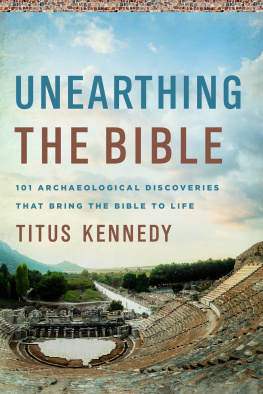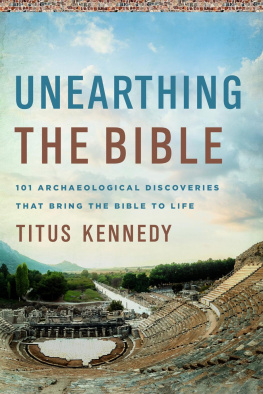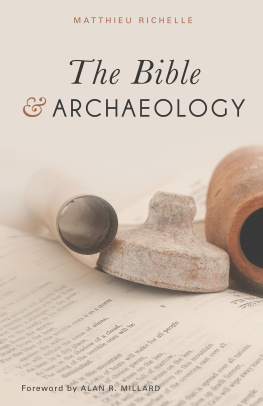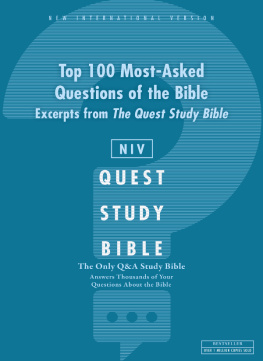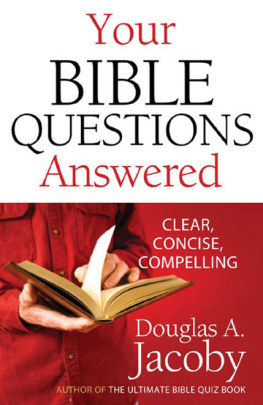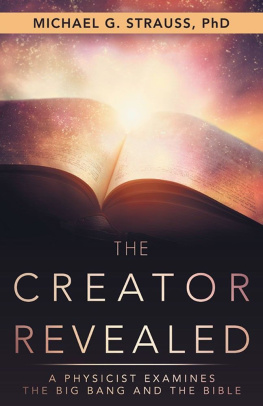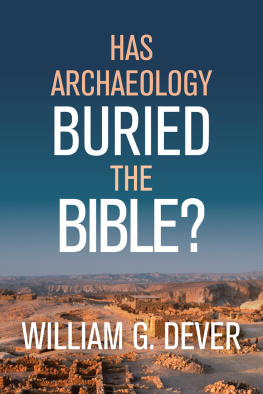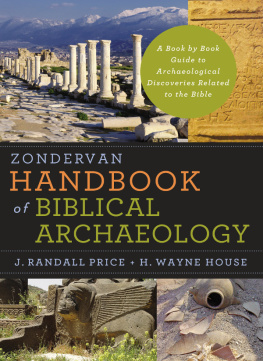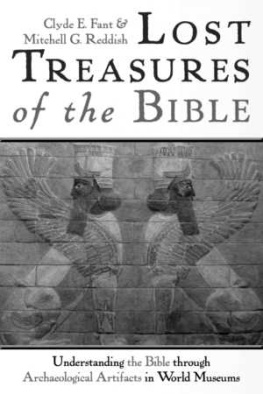Table of Contents
Guide


HARVEST HOUSE PUBLISHERS
EUGENE , OREGON
Unless otherwise indicated, all Scripture quotations are from the New American Standard Bible, 1960, 1962, 1963, 1968, 1971, 1972, 1973, 1975, 1977, 1995 by The Lockman Foundation. Used by permission. (www.Lockman.org)
Verses marked NET are quoted by permission. Quotations designated ( NET ) are from the NET Bible copyright 1996-2006 by Biblical Studies Press, L.L.C. All rights reserved.
Top photo on page 59 and photos on pages 146 and 234 are from Wikimedia. The Sphinx of Giza by Maison Bonfils, and John Rylands Papyrus by papyrologist Bernard Grenfell, courtesy of JRUL.
The James ossuary photos on pages 224 and 225 are Paradiso and used with permission.
All other photos are Titus Kennedy.
Cover design by Studio Gearbox
Cover photo Infinity T29, Pakhnyushchy / Shutterstock
Unearthing the Bible
Copyright 2020 by Titus Kennedy
Published by Harvest House Publishers
Eugene, Oregon 97408
www.harvesthousepublishers.com
ISBN 978-0-7369-7915-3 (pbk)
ISBN 978-0-7369-7916-0 (eBook)
Library of Congress Cataloging-in-Publication Data
Names: Kennedy, Titus Michael, author.
Title: Unearthing the Bible: 101 archaeological discoveries that bring the Bible to life / Titus Kennedy.
Description: Eugene: Harvest House Publishers, 2020. | Includes index. | Summary: In Unearthing the Bible, Dr. Titus M. Kennedy presents 100 objects from more than 50 museums, private collections, and archaeological sites, to offer strong and compelling evidence for the historical accuracy of ScriptureProvided by publisher.
Identifiers: LCCN 2019060224 (print) | LCCN 2019060225 (ebook) | ISBN 9780736979153 (trade paperback) | ISBN 9780736979160 (ebook)
Subjects: LCSH: BibleAntiquities. | Middle EastAntiquities.
Classification: LCC BS621 .K38 2020 (print) | LCC BS621 (ebook) | DDC 220.9/3dc23
LC record available at https://lccn.loc.gov/2019060224
LC ebook record available at https://lccn.loc.gov/2019060225
All rights reserved. No part of this electronic publication may be reproduced, stored in a retrieval system, distributed, or transmitted in any form or by any meanselectronic, mechanical, digital, photocopy, recording, or any otherwithout the prior written permission of the publisher. The authorized purchaser has been granted a nontransferable, nonexclusive, and noncommercial right to access and view this electronic publication, and purchaser agrees to do so only in accordance with the terms of use under which it was purchased or transmitted. Participation in or encouragement of piracy of copyrighted materials in violation of authors and publishers rights is strictly prohibited.
C ONTENTS
I first became enchanted with biblical archaeology on a trip to Israel in 1989. During a walking tour in the old city of Jerusalem, a guide showed us some of the bullae or signet rings of Judahite officials that had been preserved since the Babylonian destruction of Jerusalem in 587 BC. The bullae bore the names of minor officials in the court of King Jehoiakim. I was fascinated by the detailed extrabiblical corroboration of specific events and biblical figures. I saw many more examples of such evidence during a month-long visit to Israel that year. That experience kindled in me what has become a lifelong fascination with such archaeological evidence.
During a sunny afternoon on an outdoor basketball court, I met Titus Kennedy. At the time, Titus was a senior in high school, and I was a young university professor teaching the philosophy of science. Titus distinguished himself on the court that day as he has done in nearly every facet of his life since. After the game, as the two of us stayed around and continued to shoot hoops, we struck up a conversation. Learning that he was going off to college, I asked him what major he planned to pursue. He told me he wanted to study archaeology and ancient history connected to the Bible. We soon discovered we had lots to discuss. As it turned out, I was teaching a course called Reasons for Faith that included a series of lectures on the evidence for the historical reliability of the Bible, primarily from archaeology.
Several years after this chance encounter, I reconnected with Titus. At the time, I was preparing to teach a filmed version of Reasons for Faith in front of a student audience for distribution as part of the TrueU series. By this time, Titus had finished a masters degree in Near Eastern archaeology from the University of Toronto. As a result of his studies, travels, and excavations, he had also acquired an expertise about the many archaeological artifacts connected to the historical narratives in the Bible. After hearing about the project, Titus agreed to review, fact check, and add to the archaeological content of my lectures. That turned out to be a good move on my part. It soon became apparent that Titus knew virtually everything there was to know about every known relevant artifact corroborating or otherwise illuminating the biblical narrative. During this preparation, I also learned that Titus possessed a rare commitment to both scientific rigor and biblical authority. A few years later, Titus received his doctorate in biblical archaeology from the University of South Africa for his work on the demography of Canaan during the period of Moses, Joshua, and the judges. We also taught a memorable summer course together in Cambridge, England, capped with an unforgettable tour led by Titus through the British Museum. Over those hours in the museum, biblical history came to life for our students.
Based on my experience working so closely with Titus on these and other projects, I can highly recommend this book. Many in our elite media and academic culture reflexively reject the biblical message as factually and historically inaccurate, thinking that surely the relevant archaeological evidence supports such a judgment. This book instead shows that a surprising array of evidence supports the historical reliability of the biblical text, and does so across different periods of biblical history, from the time of Abraham to that of Moses, Joshua, David, Hezekiah, Daniel, Jesus, and Paul.
In documenting and displaying these objects, Dr. Kennedy provides information about where they were found and when they were createdwhat archaeologists call provenancing and dating. He also provides important insight into their interpretation and relevance to understanding the biblical text. His beautiful photographs of these artifacts also help bring them, and the events to which they attest, to life. The pictures and articles in this book will ignite the same kind of interest for many readers. Many will also find this volume a helpful aid in their own Bible study. Think of it as a kind of archaeological commentary on historical narratives in the biblical books.
Titus Kennedy is a dedicated archaeologist who has traveled to difficult locations, slept with scorpions, and lowered himself into excavation shafts to document critical archaeological evidence supporting the Bible. No one else I know combines such a fearless spirit of adventure, love of the Bible, knowledge of ancient languages, careful scholarship, and archaeological expertise. Having part of this knowledge under one cover, illustrated with color photographs, makes this book a treasure. Read, view, and enjoy!
Next page
